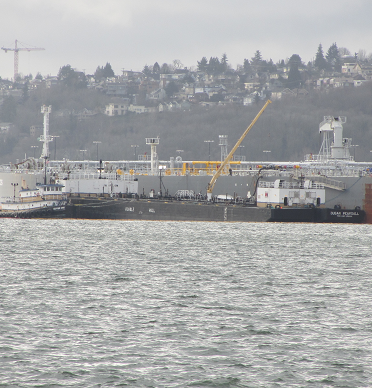Oil transfers and transfer inspections
Our oil transfer requirements apply to bulk oil-transfer operations moving product to or from vessels. These operations can happen at regulated facilities, between vessels, or at pier. We use inspections to ensure the use of proper equipment and procedures during transfers, including advance notice of the transfer operation and pre-booming of the transfer area.
Historically, bulk oil transfers contributed to the majority of spills in state waters. Our oil transfer rules (Chapter 173-180 WAC and Chapter 173-184 WAC) help prevent these kinds of spills from non-recreational vessels. These rules apply to regulated facilities and vessels that deliver oil in bulk over or near navigable waters of the state.
At-anchor oil transfer inspections
We use commercial launch services for transportation to anchorage locations. Our at-anchor inspections are no different from our dockside oil transfer inspections. They help industry meet the mandates of state law and educate ship crews.
Oil transfer requirements outline the procedures and equipment standards needed for safe oil transfers. Our oil transfer rules generally focus on the following elements:
- Oil transfer equipment requirements.
- Guidance and training for oil handling personnel.
- Limitations on maximum work hours.
- Communication and coordination between transfer personnel.
- Twenty-four hour advance notice of oil transfers.
- Applying boom prior to the transfer and weather restrictions.
Read more information about how this program applies to facilities and vessels.
Reporting transfers
Advance notice of transfer requirements typically apply to Class 1, 2, and 3 facilities and delivering vessels. The exception to the above is anyone delivering less than 100 gallons of oil may not have to provide advance notice of the transfer.
Class 4 facilities are not required to provide advance notice, but must report bulk oil transfer operations involving non-recreational vessels twice per year. This reporting requirement does not apply to marinas or fueling stations that transfer exclusively to recreational vessels.
All regulated facilities must:
- Regularly inspect and test all hoses, piping, and transfer equipment to ensure they are in good working order.
- Follow industry standards and ensure pre-operation safety checks are conducted.
- Have the right type and amount of on-site response equipment, such as personal protective equipment, sorbents, containment boom, and other appropriate gear. The equipment must be easily accessible.
We use this Delivering Facility Transfer Checklist when inspecting oil transfers from delivering facilities.
There are two types of oil transfers involving vessels — vessels delivering oil and vessels receiving oil.
- Transfers when vessels are receiving oil from a facility follow the oil transfer requirements for facilities found in Chapter 173-180 WAC.
- Delivering vessels follow the oil transfer requirements for vessels found in Chapter 173-184 WAC.
Delivering vessels must ensure that the boom used during a transfer operation is appropriately designed and sized for the transfer area, and must also have enough sorbent materials and storage capacity for a seven barrel oil spill.
We use these checklists when inspecting oil transfers for delivering vessels.
Related links
Contact information
Jason Reichert
Oil Transfer Inspector Lead
jason.reichert@ecy.wa.gov
360-584-2799


